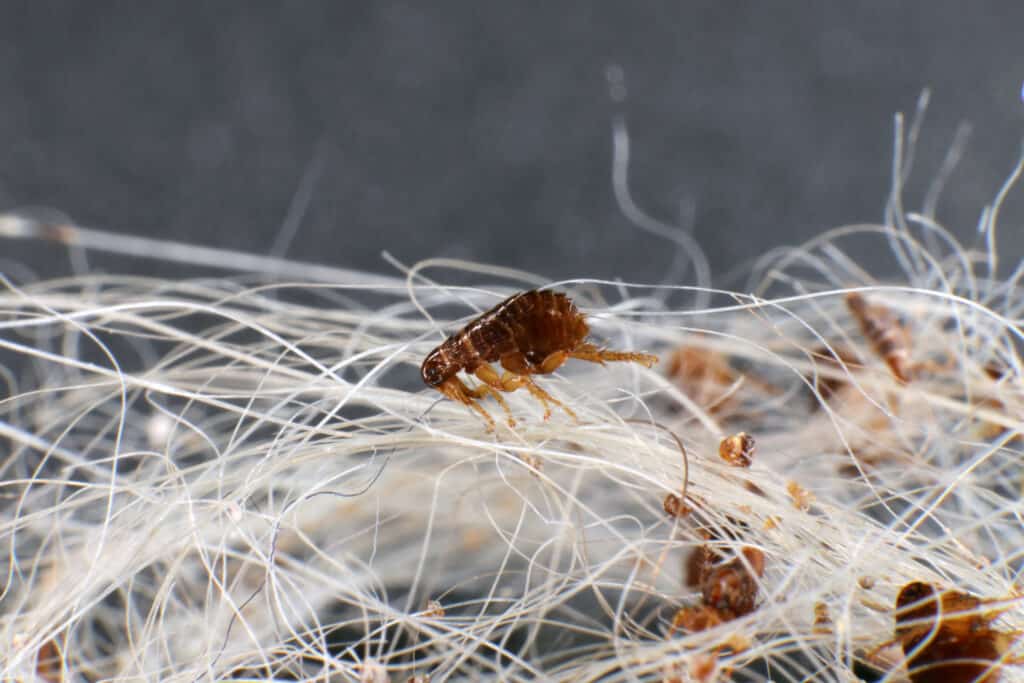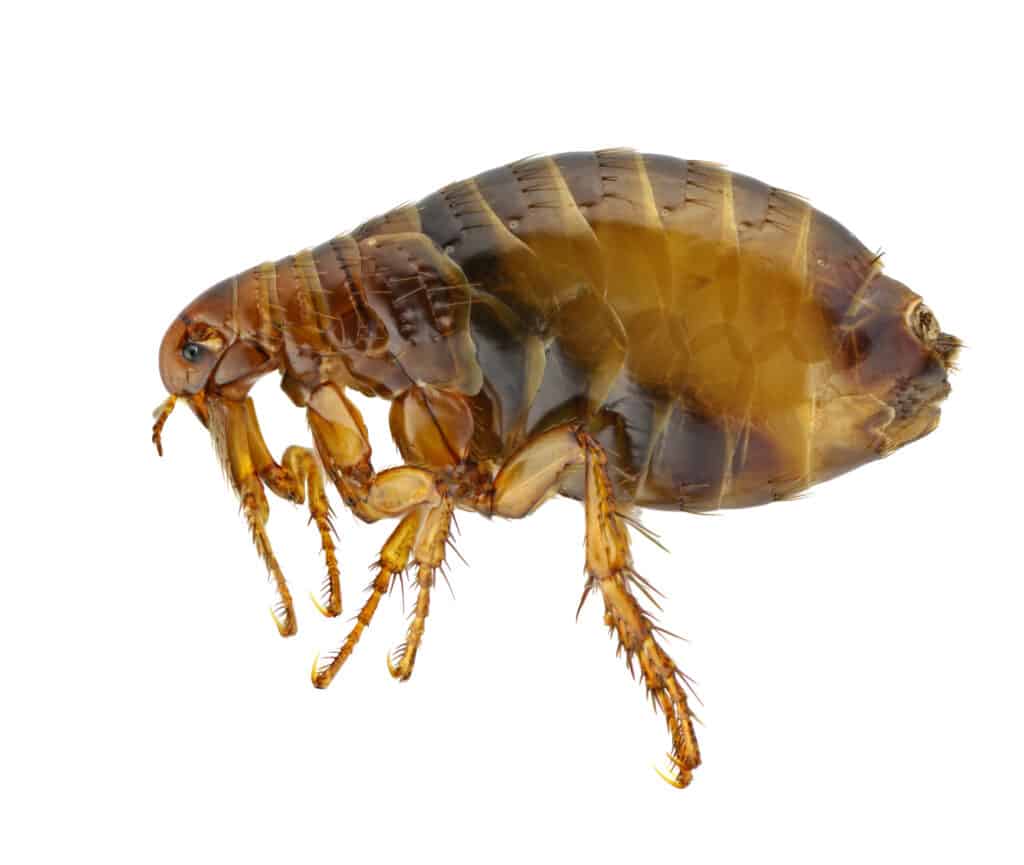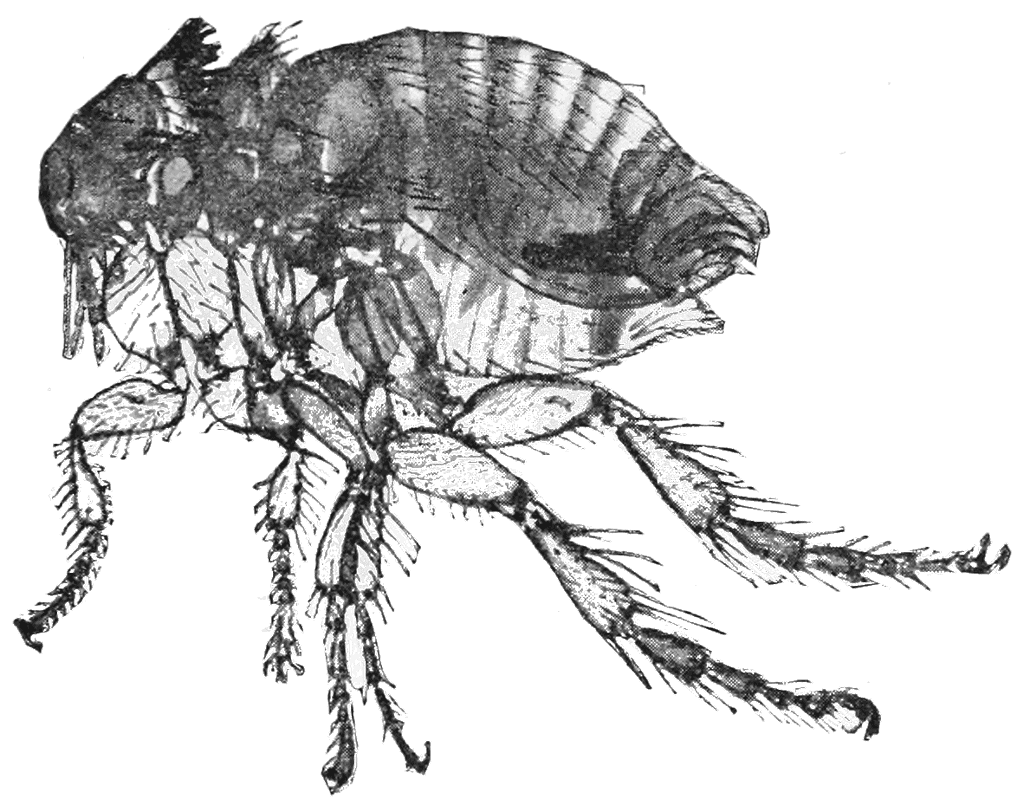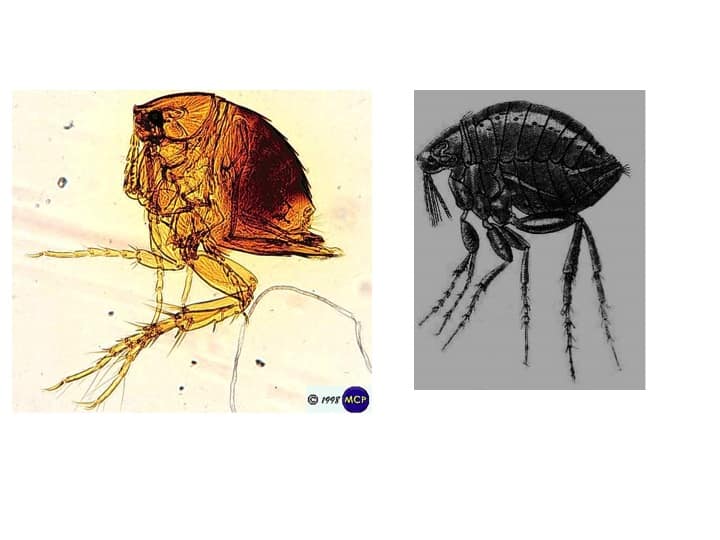Did you know that there are more than 2,000 types of fleas that live all around the world? Fleas may be tiny, but they can wreak havoc on animals (even humans) much larger than they are. These tiny, pesky parasites come in all sorts of shapes and sizes, and while many of them are harmless, some can cause serious health issues for you and your dog. Not only can fleas make life very uncomfortable for your canine companion, but they also can spread disease and infections. In puppies, fleas can even cause anemia and become life-threatening. So, let’s take a closer look at the common types of fleas you don’t want on your dog!
1. Cat Fleas (Ctenocephalides felis)

Cat fleas can also transmit diseases and infections, especially if you live with cats as well as dogs.
©Cosmin Manci/Shutterstock.com
Believe it or not, the most common types of fleas that you may find on your dog are cat fleas! Despite their name, these tiny insects prefer to live and feed off of not only cats but humans and dogs as well. They will cause some serious itching and irritation for your precious pup, but that’s not the only reason you don’t want them on your dog. Cat fleas can also transmit diseases and infections, especially if you live with cats as well as dogs. These insects can transmit cat scratch disease (Bartonella henselae) and flea-borne spotted fever (Rickettsia felis) and can also assist in spreading parasitic worms in cats.
2. Dog Fleas (Ctenocephalides canis)

Dog fleas can cause extremely intense itching as well as allergic dermatitis.
©photowind/Shutterstock.com
In addition to the ironically named cat fleas, your dog can also get dog fleas as well. Dog fleas are a common type of flea that feed on livestock and many wild animals like opossums and raccoons. These fleas can quickly transfer to other animals, humans, cats, and of course, dogs. Dog fleas can cause extremely intense itching as well as allergic dermatitis. In addition, some dog fleas carry common tapeworm parasites, which can then be transferred to the dogs and cats in your home — which is not something you want!
3. Human Fleas (Pulex irritans) and False Human Fleas (Pulex simulans)

Some human fleas can also carry the rather nasty plague bacterium (
Yersinia pestis).
©Cosmin Manci/Shutterstock.com
Did you know that not only are there cat and dog fleas, but there are human fleas as well? Like their name, human fleas prefer human hosts for their meals, although they also feed from animals like dogs, cats, coyotes, and pigs. Fortunately, human fleas are not quite as effective at spreading disease, but they have been known to spread parasitic worms like Hymenolepis nana and Dipylidium caninum.
Some human fleas can also carry the rather nasty plague bacterium (Yersinia pestis). Yes, that plague — the one that was responsible for taking out millions of people during the Middle Ages in Eurasia! While it is not unheard of, plague is not a very common issue in the United States these days. It does cause many infections in parts of Asia and Africa, however. Unlike those in the Middle Ages though, prompt treatment with today’s modern medicine can take care of cases of plague just fine. But you can see why you don’t want human fleas on your dog!
False human fleas are found in the same areas as human fleas and commonly feed off of cats and dogs. They also target raccoons, opossums, and other animals in the canine family like foxes and coyotes. Since they live in the same areas and are closely related, false human fleas are often misidentified as human fleas.
4. Sticktight Fleas (Echidnophaga gallinacea)

These little insects are a dark brown color, and they embed their heads deeply in the flesh of their host. Just brushing them off won’t do the trick!
©The noob ph/Shutterstock.com
Also known as tropical hen fleas, sticktight fleas are another pesky parasite that you don’t want on your dog. You may see clusters of these pesky fleas hanging out around the waddles, combs, eyes, and other bare spots on birds. Fortunately, they mainly target poultry and birds like chickens and turkeys. However, sticktight fleas will also go for a dog, cat, or human if there is one nearby! Sticktight fleas can also feed on foxes and various types of rodents, especially in the Southern United States.
These little insects are a dark brown color, and they embed their heads deeply in the flesh of their host — which means, unfortunately, that just brushing them off won’t do the trick! However, you can remove them with specialized tweezers much like you do with ticks. Just be sure to use an antibiotic ointment afterward to prevent any infections.
Sticktight fleas are a common type of flea that will often congregate at the outer margin of your dog’s ears, or between their cute little paw pads. Fortunately, sticktight fleas don’t transmit diseases, but because of the way they attach to their hosts, they can cause secondary infections. If there are enough of them, sticktight fleas can also cause swelling and create obstructions that might keep your dog from eating properly.
5. Oriental Rat Flea (Xenopsylla cheopsis)

Rat fleas are also a primary carrier of nasty diseases like the bubonic plague and murine typhus.
©Yale Peabody Museum (Daniel J. Drew), CC0, via Wikimedia Commons – License
Although oriental rat fleas (also called tropical rat fleas) prefer rats, they will feed off of other warm-blooded animals like humans, cats, and dogs if they need to. Unfortunately, rat fleas are also a primary carrier of nasty diseases like the bubonic plague and murine typhus. If a rat flea feeds from an infected rodent and then bites you or your dog, it can spread these diseases. In addition, Oriental rat fleas are also hosts for tapeworms like Hymenolepis nana and Hymenolepis diminuta — so you’re not going to want these common types of fleas going anywhere near your dog!
6. Rabbit Fleas (Spilopsyllus cuniculi)

These sneaky fleas can wiggle their way through your pet’s lovely fur coat, but they seem to prefer to cluster around the base of their ears instead.
©
Although they are the most common type of flea on rabbits and hares, rabbit fleas will sometimes feed on cats and dogs as well. These sneaky fleas can wiggle their way through your pet’s lovely fur coat, but they seem to prefer to cluster around the base of their ears instead. When they feed on cats and dogs, rabbit fleas usually stay around the ears, which can cause uncomfortable and painful papules and crests.
Unfortunately, rabbit fleas are also the culprits behind viral outbreaks of myxomatosis in rabbits, which can be deadly. Myxomatosis causes the poor bunnies’ eyelids and lips to swell up, along with yucky conjunctivitis. It can even create early tumors on the rabbits’ faces, ears, and limbs. In addition, rabbit fleas can carry the Bartonella alsatica bacterium, an opportunistic pathogen that causes trouble in both animals and humans.
7. Burrowing Fleas (Tunga penetrans)

Burrowing fleas commonly target dogs and cats, as well as rats, cows, and pigs.
©Michael Wunderli, CC BY 2.0, via Wikimedia Commons – License
Now, it is important to note here that burrowing fleas (also called chigoe, nigua, or jigger fleas) are not at all common in the United States. The only cases known in the U.S. resulted from people who had traveled to infested areas and brought them back. However, burrowing fleas are a common type of flea in many rural areas of the American continent, where they are a huge problem for dogs and cats.
Some people call them sand fleas, but real sand fleas are a type of tiny crustacean. However, burrowing fleas do live in sand, especially in areas with moist sand, although that is not where their name comes from. Instead, it comes from the habits of the female burrowing flea. Female burrowing fleas not only bite and drink the blood of their hosts, but they also burrow under the host’s skin and lay their eggs there!
Burrowing fleas commonly target dogs and cats, as well as rats, cows, and pigs. Fortunately, burrowing fleas can’t jump very high, so most of the time they can be found on the lower part of legs or feet, and especially in and around a dog’s paws. If your dog is troubled by burrowing fleas, you may see black dots on their skin, along with skin lesions, intense itching, and sloughing skin. However, burrowing fleas are typically only a problem in very rural or impoverished areas from Mexico to Northern Argentina.
How Do Dogs Get Fleas?
Fleas cannot fly, but they are great jumpers. That means that your dog can get fleas just from being near other flea-infested animals, or even in areas with fleas. Your dog might have gotten fleas from a visit to the groomer, a dog park, a boarding facility, a doggie daycare, or from going for walks in wooded and grassy areas. This is why it is very important to check your dog anytime they come back into the house. Mice also carry fleas, so you don’t want them creeping around your house either. In addition, even you can accidentally bring fleas into your house from being around animals or places with fleas, since fleas can stick to your clothing or shoes when.
What do Fleas Look Like?
Fleas are tiny parasitic insects that feed on the blood of animals like mammals and birds. They have very small, wingless bodies that kind of look like tiny seeds. Although fleas are tiny, they are not microscopic. Measuring around 1/8 of an inch long, you can see them with the naked eye. however, they move very quickly so sometimes it can be hard to detect them. Fleas are shiny black, brown, or reddish with protective exoskeletons and powerful hind legs for fast jumping. Their long, pipe-like mouths are made to pierce the skin of birds and mammals so that they can feast on the blood of their unsuspecting hosts.
Fleas have a life cycle of four different stages: adult fleas, eggs, larvae, and pupae. Each of these life stages can last a couple of weeks or even a couple of months depending on the temperature and climate. This is why it is so important to treat fleas over a couple of months so that you can be sure that there is no chance they will come back and bother your dog again!
How Can I Tell If My Dog Has Fleas?

Some dogs also suffer from flea allergy dermatitis (FAD).
©natnaree sangkaew/Shutterstock.com
When a dog is affected by fleas, it will bite the dog’s skin, causing irritation and intense itching. As a result, your dog will likely be scratching their skin a lot and maybe even biting at it. Some dogs also suffer from flea allergy dermatitis (FAD). This means that your dog has an allergy or hypersensitivity to the fleas’ saliva, which will create even more severe itching that can last much longer than usual.
Dogs will also exhibit a lot of discomfort and restlessness, as well as crested skin (especially at the base of the tail and over their hips or thighs), scabbing, hair loss, and possibly thick or darker skin if the infestation is chronic.
You might be able to see the fleas or some flea dirt, but you will not be able to see any eggs or larvae. Flea dirt — which looks kind of like dark dandruff — is usually easier to see than the fleas themselves. It is excrement from the fleas after they have digested your dog’s blood. If you’re not sure if what you see is, in fact, flea dirt, you can brush it onto a cloth. Add a drop of water, and if the dirt turns a reddish-brown color, then that is a good sign that there have been fleas on your dog recently.
If your dog is exhibiting any signs that it might have fleas, you should check its body closely — especially on the insides of its hind limbs and at the base of its neck and tail. You can also have your veterinarian examine your dog to help diagnose the cause of their discomfort.
How Can I Get Rid of the Fleas on My Dog?

Although getting fleas is not at all fun for you or your dog, you can, fortunately, treat fleas and get rid of them!
©Roman Chazov/Shutterstock.com
Although getting fleas is not at all fun for you or your dog, you can, fortunately, treat fleas and get rid of them! Your vet can prescribe medications for your dog that kill adult fleas on their skin very quickly. They can also give you medicine that will help to prevent re-infestation, as well as medication that will help to soothe your dog’s skin and help them be more comfortable. If your dog’s skin is infected due to the flea infestation, you might need your vet to prescribe an antibiotic as well.
Flea Life Cycle
However, it is important to note that just because you can no longer see fleas, it does not mean that they are completely gone for good! Remember, fleas have a four-stage life cycle, so even if you kill the adult fleas, there are likely still flea eggs, larvae, or pupae that are just waiting to attack again. You will need to treat your pet for a couple of months so that you can get rid of all infestations and various life cycles of fleas that may be in your home or on your dog.
Home Maintenance
In addition, you will need to treat your home with special treatments to kill fleas, their eggs, and larvae. Wash bedding, clothing, fabric items, and any items like plush toys in hot water, as this will remove and kill any flea eggs and larvae that may be living on them. In addition, you should vacuum all hard surfaces and crevices where fleas may be hiding, and immediately empty the vacuum into an outdoor trash can. In some cases, you may also need to hire a professional pest exterminator to rid your home of any fleas.
How Can I Protect My Dog From Fleas?

There are many preventative flea treatments available in both topical and oral forms that you can administer to your dog each month.
©Masarik/Shutterstock.com
As you can see, you don’t want fleas on your dog! Not only do they cause pain and discomfort, but they can also transmit disease and infections, and cost you a lot to get rid of. Fortunately, there are many easy ways to protect your dog from fleas! There are many preventative flea treatments available in both topical and oral forms that you can administer to your dog each month to protect them from any type of fleas. If you’re concerned about which one to use, you can talk to your veterinarian, and she will help you select the right one for your dog.
However, just be sure that you do not miss a treatment — you don’t want to leave any openings for any type of pesky flea to make their home on your dog’s skin! Although it may seem to be a hassle, in the long run investing in these monthly treatments for flea protection saves you time and money.
The photo featured at the top of this post is © iStock.com/adogslifephoto
Ready to discover the top 10 cutest dog breeds in the entire world?
How about the fastest dogs, the largest dogs and those that are -- quite frankly -- just the kindest dogs on the planet? Each day, AZ Animals sends out lists just like this to our thousands of email subscribers. And the best part? It's FREE. Join today by entering your email below.
Thank you for reading! Have some feedback for us? Contact the AZ Animals editorial team.






